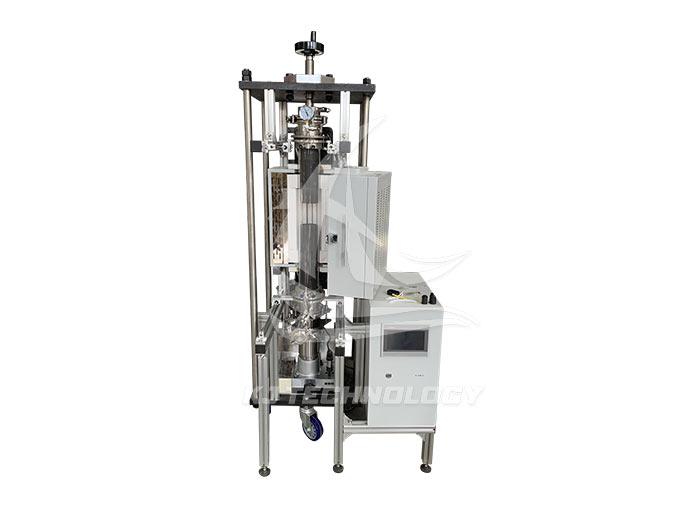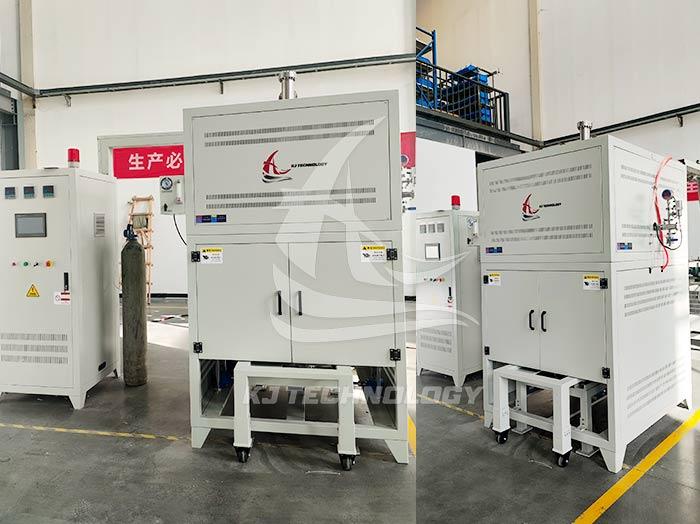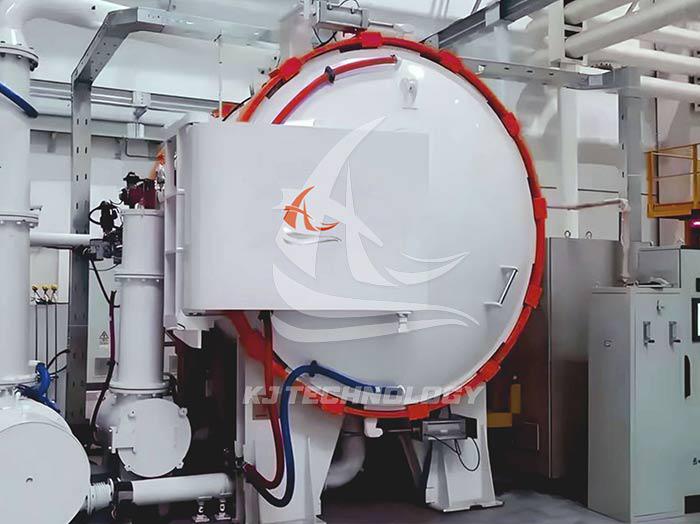Can a vacuum powder sintering furnace sinter ceramic materials?
 09-09-2025 Author: KJ technology
09-09-2025 Author: KJ technology
The vacuum powder sintering furnace can sinter ceramic materials and has significant advantages in the field of ceramic preparation. Its core principles and process characteristics are as follows:
1. The adaptability of vacuum sintering to ceramic materials
Eliminate pores and impurities
Ceramic bodies usually contain soluble gases such as water vapor, hydrogen, and oxygen, as well as insoluble gases such as carbon monoxide, carbon dioxide, and nitrogen. The vacuum environment (pressure ≤ 1 × 10 ⁻ ³ Pa) can significantly reduce the solubility of these gases, promoting their diffusion through grain boundaries or grains during the initial sintering stage (degreasing stage), thereby reducing the formation of pores. For example, after vacuum sintering, the density of alumina ceramics increases.
Promote particle binding and densification
Vacuum sintering accelerates material migration (such as viscous flow and diffusion) by reducing the surface tension between powder particles, making it easier for particles to bond at high temperatures. For difficult to sinter ceramics such as silicon nitride and silicon carbide, a vacuum environment can avoid oxidation reactions, while achieving high density through liquid-phase sintering (such as adding Y ₂ O3 as an additive).
Control grain growth and microstructure
Vacuum sintering can suppress grain boundary migration, reduce abnormal grain growth, and thus obtain a fine grain microstructure. For example, after vacuum sintering, the grain size of nano alumina ceramics can be controlled, and isolated pores are completely eliminated, improving the strength and toughness of the material.
2. Types of ceramic materials that can be sintered
Oxide ceramics
Aluminum oxide (Al ₂ O3): including ordinary aluminum oxide, nano aluminum oxide, and transparent aluminum oxide. Vacuum sintering can significantly improve its density and transmittance.
Zirconia (ZrO ₂): High strength dental implant or tool coatings can be prepared by vacuum sintering through partial stabilization treatment (such as adding Y ₂ O ∝).
Nitride ceramics
Silicon nitride (Si ∝ N ₄): vacuum sintering combined with hot isostatic pressing (HIP) can prepare bearing balls with better wear resistance and longer lifespan.
Aluminum nitride (AlN): After sintering, its thermal conductivity is improved and it is used as a heat dissipation substrate for high-power LEDs. Its thermal expansion coefficient matches that of silicon.
Carbide ceramic
Silicon carbide (SiC): a nuclear fuel cladding material prepared by vacuum sintering, with excellent neutron radiation resistance and good strength retention at 1600 ℃.
Tungsten carbide (WC): sintered hard alloy mixed with cobalt powder, with higher hardness, used for drill bits and cutting tools.
Special functional ceramics
Boron compounds (such as B ₄ C): vacuum sintering is used to prepare neutron absorbing materials for nuclear reactor control rods.
Bioactive ceramics (such as hydroxyapatite): After sintering, the bonding strength with bone tissue is enhanced, promoting bone healing.
3. Process advantages of vacuum sintering ceramics
Low temperature sintering and energy saving
A vacuum environment can lower the sintering temperature of ceramics (usually 50-100 ℃ lower than air sintering) and reduce energy consumption. For example, the vacuum sintering temperature of silicon nitride ceramics can be reduced from 1800 ℃ to 1700 ℃ while avoiding performance degradation caused by oxidation.
Ability to form complex shapes
By combining powder injection molding (MIM) or 3D printing technology, vacuum sintering can directly prepare near net shape ceramic parts (such as turbine blades and electronic packaging substrates), reducing subsequent processing volume. The data shows that the size shrinkage rate of MIM zirconia ceramic parts after vacuum sintering is controllable.
Environmental Protection and Clean Production
The vacuum system operates in a closed manner, with no exhaust emissions, and meets environmental standards. Compared to traditional air sintering, which requires subsequent acid washing to remove oxide scales (resulting in heavy metal containing wastewater), vacuum sintering does not require this step and has higher cleanliness.
4. Typical application scenarios
aerospace
Silicon nitride ceramic turbine rotor: After vacuum sintering, it has high bending strength and temperature resistance up to 1400 ℃, and is used for weight reduction in aircraft engines.
Alumina ceramic radar cover: Vacuum sintering has higher transmittance and high strength.
Electronics and Optoelectronics
Aluminum nitride ceramic heat dissipation substrate: After vacuum sintering, the thermal conductivity is enhanced, which is used for 5G base station power amplifiers to improve heat dissipation efficiency.
Transparent alumina ceramic window: Vacuum sintered with high transmittance, used in fields such as laser communication and deep-sea exploration.
Biomedical
Hydroxyapatite ceramic artificial bone: After vacuum sintering, the porosity is controllable, promoting bone cell growth and excellent compatibility with human tissues.
Zirconia ceramic dental crowns: After vacuum sintering, they have high strength, wear resistance several times higher than natural teeth, and a longer service life.








